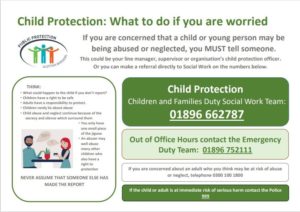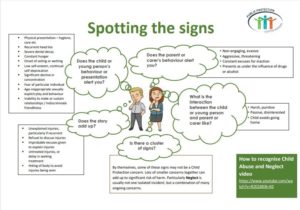Child Protection
What is it?
“Every child in Scotland has the right to be kept safe from abuse, neglect, exploitation and any other kind of harm that puts them at risk.”
(Child Protection Scotland, Scottish Government website)
“What is Child Protection?
1.50 Child protection refers to the processes involved in consideration, assessment and planning of required action, together with the actions themselves, where there are concerns that a child may be at risk of harm…
Child protection involves:
- immediate action, if necessary, to prevent significant harm to a child
- inter-agency investigation about the occurrence or probability of abuse or neglect, or of a criminal offence against a child. Investigation extends to other children affected by the same apparent risks as the child who is the subject of a referral
- assessment and action to address the interaction of behaviour, relationships and conditions that may, in combination, cause or accelerate risks
- focus within assessment, planning and action upon listening to each child’s voice and recognising their experience, needs and feelings
- collaboration between agencies and persistent efforts to work in partnership with parents in planning and action to prevent harm or reduce risk of harm
- recognition and support for the strengths, relationships and skills within the child and their world in order to form a plan that reduces risk and builds resilience”
(National Guidance for Child Protection in Scotland, Scottish Government, 2021, p. 14/15).
“We have a distinctive approach to safeguarding in Scotland linked to Getting It Right for Every Child (GIRFEC), which promotes action to improve the wellbeing of every child and young person. Safeguarding is a golden thread that runs through the curriculum. The aim is to support the development of learner’s knowledge, skills and resilience to keep themselves safe and protected, and to develop an understanding of the world so that they can respond to a range of issues and potential risky situations arising throughout their lives. As such, it permeates many features of the education experience including leadership, values, vision, the curriculum, learning and teaching, positive relationships, building learner resilience and suchlike”
(Child Protection and Safeguarding Policy, Education Scotland, February 2021, p 3).
Key messages:
All practitioners:
- Are appointed following appropriate and stringent safe recruitment procedures.
- Have current Child Protection Training at the required level.
- Have an understanding of the different ways a child may be abused and may need protection from.
- Understand their role in ‘safeguarding’ children.
- Understand how safeguarding runs through the curriculum, it’s importance in supporting the protection of children and their role in providing appropriate opportunities across experiences, spaces and interactions to develop this.
- Understand and adhere to the settings safeguarding and child protection procedures.
- Value and maximise a multi-agency approach where appropriate in relation to safeguarding and child protection. All communication with other agencies adheres to GDPR guidance.
- Value the importance of positive relationships with each other, children, families and other agencies in supporting their role within safeguarding and child protection of the child as an individual.
Settings must have robust and clear procedures to follow, should practitioners have concerns regarding safeguarding and child protection.
Ways we can do this:
Recruitment procedures:
- All procedures detailed in SBC Safe Recruitment Policy and supporting guidance are followed.
Please note this is the responsibility of the setting manager or the Senior Lead Team.
Child protection training:
- Practitioners new to SBC education settings must attend mandatory Child Protection Induction training.
- Existing practitioners attend the annual child protection training update. (This training can be accessed via Business World).
- Practitioners have engaged with appropriate training in relation to The Rights of the Child (UNCRC)
- Settings have a designated member of staff with Child Protection Co-Ordinator responsibilities. This person has a strategic overview and appropriate training to respond effectively to child protection concerns, support staff and to share any key learning/ messages.
Knowledge and understanding:
- All practitioners recognise the different ways a child may be abused and need protection from neglect (NEGLECT Toolkit); physical and emotional abuse; and sexual abuse (online, exploitation, trafficking, female Genital Mutilation and forced marriage). For more information see Child Protection Scotland
- Practitioners understand their role in ‘safeguarding’ children, with a shared, detailed and working knowledge of Getting It Right For Every Child (GIRFEC) that is used effectively to support individual needs.
- Practitioners understand and use approaches to build strong, effective and positive relationships with each other, all children, families and other agencies.
- Practitioners use Nurturing and Restorative Approaches.
- Practitioners understand how safeguarding runs through the curriculum, its importance to supporting the protection of children and their role in providing appropriate opportunities across experiences, spaces and interactions to develop this.
Positive relationships:
- All practitioners value the importance of Positive Relationships with each other, children, families and other agencies in supporting their role within safeguarding and child protection of the child as an individual:
- All practitioners approach both children and families in an open, non-judgemental, responsive and nurturing way.
- All practitioners make time to listen to children and parents. They value their voices including any concerns they may have.
- All practitioners use sensitive interactions with both children and families, acting in a way that is responsive to each family’s unique circumstances. They use training such as MAP (Motivation Action Prompt) of Behaviour Change to support this.
Documents and resources:
All practitioners should be familiar with and make use of the following documents and resources.
- The Health & Wellbeing Across Learning: Responsibilities of All Experiences and Outcomes within Curriculum planning.
- GIRFEC/ Health and Wellbeing indicators to support individual needs, learning and development.
- Developmentally appropriate resources are used to support the Health and Wellbeing Curriculum. These may include Oh Lila, Do be Mindful, NSPCC resources and NHS Greater Glasgow and Clyde’s Building Resilience Toolkit.
The above resources support opportunities for protecting and promoting children’s rights, wellbeing and safety, including helping children develop in their ability to keep themselves and others safe; and helping them learn how to get help and support if they need it and knowledge, skills and values associated with healthy choices and relationships.
Reporting concerns procedure:
“Anyone who has concerns about a child’s wellbeing should listen to the child and their family’s views and consider the following key questions:
- What is getting in the way of this child or young person’s wellbeing?
- Do I have all the information I need to help this child or young person?
- What can I do now to help this child or young person?
- What can my agency do to help this child or young person?
- What additional help, if any, may be needed from others?
(Scottish Government, 2021a).
- Settings have robust and clear procedures to follow should practitioners have concerns regarding safeguarding/ child protection.
- All practitioners understand and adhere to the settings safeguarding/ child protection procedures.
- All settings have a specific Child Protection Policy. All practitioners are familiar with and use this to guide their practice.
- The setting’s Child Protection Policy is in-keeping with current national guidance and local guidance, specifically SBC Child’s Planning Manual.
- Within the setting there is a visible Flow Chart detailing procedures to follow should a practitioner have concerns relating to safeguarding/ child protection. All practitioners are familiar with and are confident to use this Flow Chart as and when needed.
- All documentation/paperwork including creation, use, sharing and storage of adheres to GDPR guidance.
- All practitioners are aware of, understand and use key documents/ paperwork as and when needed. This is inclusive of transition documentation/ Chronologies/ Personal Plans/ Seemis Wellbeing Application/ Staged Intervention/ Universal +/ Meeting around the Child (MAC)/ My World Triangle/ GIRFEC Practice Model
- All practitioners are aware and understand the importance of appropriate interactions when conversing in relation to potential child protection matters.
- All practitioners ensure positive relationships are maintained and non-leading questions are used. A scripted approach may be useful here:
-
- What has been happening?
- What is happening now?
- What might happen?
- How likely is it?
- How serious would it be?
(CHILD’S PLANNING MANUAL, Scottish Borders Council, 2021, p 8)
- Practitioners make use of open questions to gather information, such as:
- Where were you…?
- Who was with you…?
- Where was…?
- When was…?
All practitioners value and maximise a multi-agency approach where appropriate in relation to safeguarding and child protection. All communication with other agencies adheres to GDPR guidance:
“1.129 Where there is a child protection concern, relevant information should be shared with police or social work without delay, provided it is necessary, proportionate and lawful to do so. The lawful basis for sharing information should be identified and recorded.”
Why relying on ‘consent’ as the basis to share information may not be appropriate:
“1.133 UK General Data Protection Regulation (GDPR) sets a high standard for consent and, in most cases where there are child protection concerns, consent is unlikely to be an appropriate lawful basis to rely upon as it requires that individuals have real choice and control about the processing of their personal data. Relying on ‘consent’ as the lawful basis is not appropriate if, for example, refusal to give consent would prejudice a criminal investigation or might lead to serious harm to the child. Furthermore, due to the power imbalance between a child or families and the authorities, it would be difficult to demonstrate that consent was freely given. In matters of child protection, it is therefore likely that reliance on consent would be the exception and not the rule.”
(National Guidance for Child Protection in Scotland, Scottish Government, 2021, p 27)
*For more information and considerations see National Guidance for Child Protection in Scotland, Scottish Government, 2021, p27 – 32.
*For Scottish Borders specific paperwork see Child’s Planning Manual.
*NSPCC Learning website provides details about procedures, terminology and how to report concerns.
For more information: Scottish Borders Child Protection
Click on Posters for larger images



